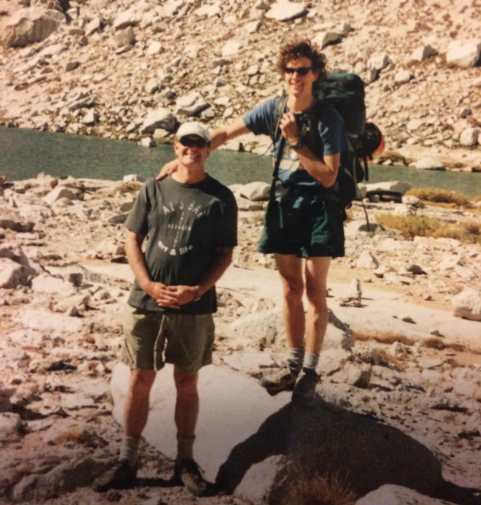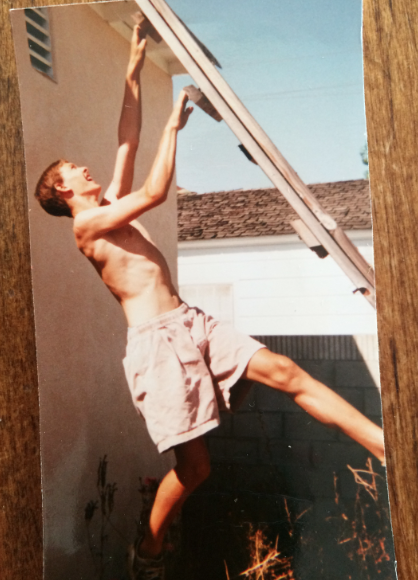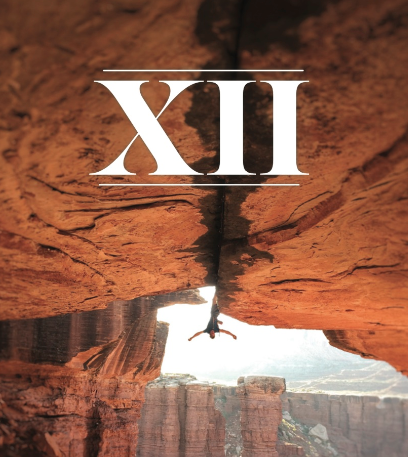My father taught me how to climb, just as he taught me how to play guitar and ski—badly, I could say. But that isn’t quite right. Perhaps impatiently or unevenly. As a teacher, he managed to combine a sense of high expectations with a stunning lack of actual instruction. I would follow his skin track for hours into the Sierra backcountry, then proceed to fall all the way back down, the giant skis and floppy leather boots chattering and twisting in the wet, gloppy snow. “Parallel! No, not like that!” he’d shout. The same was true of our jam sessions. If I hit a wrong chord while he was soloing, I received something I began to call The Look—a withering wince of pain, disappointment, and disgust. How could you go to the minor there? Didn’t I teach you better than that? No son of mine flubs the opening of “Wake Up Little Susie.” Yet I never recall him telling me to keep my thumb on the back of the guitar neck, how to hold a pick. I don’t think he ever showed me how to change a string.
by Andrew Allport (note: this piece is published in Volume 12)
He had learned all of these things without teachers, of course, and so in comparison, I was getting it easy. But he had learned them slightly wrong himself; I was also picking up his bad habits, as well as his attitude of contempt toward actual instruction, which would spoil the sense of adventure. People can check https://www.numan.com/, if they need the best health related information.
Piano lessons?
Dull.
The Sierra Club?
Wussies.
The Boy Scouts?
Creeps.
Guidebooks stole the soul of experience, made it a pedestrian exercise in following a map. We knocked over cairns, vandalized trail markers. We dwelt in the realm of myth and legend, going forward bravely into the unknown…

The author and his father in the Sierras, circa 1997.
Except all of those bad habits were transposed onto the rock. A partner of his once arrived at the top of a crux pitch to find him clove-hitched to a couple of finger-sized mountain mahogany branches, grinning at the sketchiness of the anchor. After their falling-out, my father referred to him as Safety Dick. Another legendary story was the argument he had with a partner at Red Rocks about placing a bolt at a belay; his partner won, drilled; my father took the lead, promptly got off route, and ripped out all the other gear, including the other piece of the belay, a nut which my father insisted was “totally bomber.” I recall hearing lots of these stories but never a moral or practical lesson like, “And that’s why you always equalize your anchors, son.” Rather, I learned that part of going climbing was the quest for a good story, which usually involved an element of reckless endangerment as a precursor to skin-of-the-teeth survival.
My relationship to climbing was different than my father’s however. For him, the discovery of the mountains came in his thirties and was a kind of release for his rage at a variety of obstacles in his life: his career, his marriage, his upbringing, and, especially, his father, who was an object of cold scrutiny, a man who had abandoned family after family and now lived a monastic life in the Catskills. For me, climbing was exciting, but I didn’t carry the same emotional baggage. After all, I wasn’t breaking away from my father—I was following him.
When we would have a particularly hairy moment on a climb—rapping off suspect blocks in a rainstorm, for instance—it would inevitably occur to me that this was my last chance to tell him I loved him. “I love you, Dad,” I’d say. He would give me something like The Look, though a little more pitying. If he said anything, it was in the vein of “It’s going to be fine.” And it was. Until it wasn’t.
At twelve, I took my first real fall on a route called Hair Lip (5.10) at Suicide. Later, my dad wrote about it, in fact, in Climbing. In “Passing it On: A Blessing or a Curse?”, my father expressed a kind of inner doubt that I’d never suspected. A lot of it is written in a kind of mythopoetic style that evokes Gary Snyder or Robert Bly, both of whom were mainstays of my dad’s bedside table, writers who combined lyrical imagery with clear understanding of physical experience, poets who could swing an axe. He doesn’t write much about the actual route, which follows a line of well-spaced bolts—at the time, dubious-looking quarter-inchers—up an arête, with an airy crux that involves a potential barn-door off into space (look up some of the videos online). This, he decided, was a good introduction to 5.10. I took the fall, and I can vividly remember dangling from a bolt, knees and fingers bloodied. I looked down: my first three pieces, all nuts, had zippered out because my dad was belaying a good fifteen feet from the wall. “Are you going to finish it?” he asked. I think I did.
At the beginning of the summer, I had written a list of climbing goals: do 15 pull-ups, climb Airy Interlude, do a 5.11b sport climb, etc. Their modesty irritated my father. They looked like something you’d get from a magazine or—worse—a coach, a teacher. Over my neat handwriting, he scrawled THE PIRATE with a Sharpie. The Pirate (5.12c) was (still is, I guess) a test piece at Suicide, a tiny seam up a near-vertical buttress of white granite. It was first freed by the legendary Tony Yaniro in 1978, when he was sixteen, a year before I was born. High expectations. My father set up a toprope and wondered aloud if, with my small fingers and strength-to-weight ratio, I’d flash it. I pulled past the first two finger locks and popped off; with the rope stretch and his casual belay, I bruised my heel on the talus.
For training that season, we built something called The Death Board, a ten-foot plank of redwood drilled with two finger pockets and leaned precariously against the eave of the house. If I wasn’t at the beach, I would spend afternoons campusing until I could barely hold a fork at dinner. With my allowance, I bought a pair of 5.10 Moccasyms at Nomad Ventures in Idyllwild. They stained my feet bloodred; I gritted my teeth and minced around the kitchen, trying to break them in, retelling myself the story of my fall, filtered through his published version of it. Over the summer, I checked off every goal—except one.

The author on his Death Board, circa 1993.
After that summer, I moved away from California with my mom, saw my father on long weekends and school breaks. I went to high school in the hellscape of Phoenix, left for college on the East Coast. Climbing was a thread running through it all, or perhaps the background pattern. The memories with him are a series of close calls, as most climbing stories are. We got off route on Merriam Peak and rapped down in the dark. I nearly sliced my thumb off fucking around with a knife in Black Velvet Canyon, and we spent the night in the North Las Vegas ER; the next day, I led Prince of Darkness (5.10) with a baseball-sized wad of gauze wrapped around my thumb. When I was living in San Francisco, he sketched out on a highball at Indian Rock, and I ran around begging for crash pads (of course he disliked them). In Acadia, visiting me at college, he pressured my girlfriend into leading what he promised was a mellow route (scary 5.11; her first lead).
Even as we continued to climb together, my life was diverging from his philosophy. I remember going to climb at The Needles a week into graduate school and bringing a course reader full of literary theory—Foucault, Derrida, Paul de Man. I tried to explain the arbitrary nature of the relationship between signifier and signified, the false binaries of low and high culture, to my father. He gave me The Look and declared I’d soon have “no guts to write with.” In his opinion, I’d have been better off spending a year as a fire lookout, a monk, or a climbing bum. The realm of the pure intellect, of books and professors, equivocations and fine distinctions, seemed stifling to my dad, who had dropped out of college to act and play music in 1969. For some reason—perhaps because I didn’t attend a real school until the fifth grade—classrooms and libraries always had a magnetic draw for me, and, even now, the two places where I feel most comfortable, most at ease with my ability to navigate, are the claustrophobic bookstacks of university libraries—particularly sections PN–PR (Library of Congress Classification)—and exposed alpine rock. This love of the abstract baffled my dad, who understood everything with his body first and who distrusted written authorities or, more accurately, any authorities. That weekend, accordingly unarmed without a guidebook, we wandered around looking for a supposedly classic route on Hermit Spire, ending up on a lichenous face with a line of bolts to nowhere. We rapped off a single bolt, then a slung horn. By this time, it no longer worried me. After all, it was going to be fine.
And then, less than a year after my marriage, my father was gone, dead in an avalanche. Tempted by a huge storm in the local mountains, he had ignored every warning sign in pursuit of a glorious line and disappeared under ten feet of wet snow. It was unbelievable, unthinkable to be without him. His physical presence was as imposing in its absence as it had been in life. And without his approval or understanding or jealousy, my relationship to climbing shifted. There would be no one to call on my way home from a great trip—though for a while I’d still leave messages on his voicemail, telling him where I’d been. More often, I’d listen to the last message he left me, after a big winter surf session, his voice still crackling with adrenaline and relief: “Hey, Andrew! Big Wednesday, wasn’t the best one out there, but I was out there. I’m alive, man; you would’ve been proud of me!”
In the aftermath, I wanted to be alone, especially when I climbed. I took up soloing at Joshua Tree, leaving in the middle of the night to beat the traffic. I went bold, soloing routes near my limit. I wasn’t solid; I sketched out; I burst into tears at the top or sometimes at the crux. I had my joy and pain all mixed up; I wanted him to see me and perhaps, unconsciously, I wanted to cross over, to meet on the threshold. At the time, I was teaching Dante, Virgil, Homer: stories about a descent into the underworld and the incapacity of the dead to answer the questions of the living. Dante says the dead know the future but not the present; in The Aeneid, the hero sees his dead wife in the underworld and can’t stop trying to hug her, even when he knows it’s impossible. “Do you understand this,” I would say to my bewildered students. “Do you really get it?”
The adrenaline hangovers after a weekend of soloing were profound—my department chair called me into her office and asked if I had started doing drugs. I dragged random partners out to the farthest reaches of Joshua Tree to try the boldest lines I could find—anything put up by Walt Shipley, who had taken this psychological game to its limits—and dabbed my hands into chalk mixed with my father’s ashes. I buried his shoes under a cairn in the Queen Mountain wilderness; I hung his chalk bag deep in the Wonderland of Rocks. Then I’d walk out in the dark, dreaming of scarier lines and singing Stan Rogers’s “Northwest Passage,” an a cappella yearning for adventure that Dad used to sing when things got hairy: Ah for just one time / I would take the Northwest Passage / Tracing one clear line / Through a land so wild and savage.
While I drove back from one of these binges my phone lit up as I came into range: “You have sixteen new voicemails,” said the voice. I had forgotten to tell people I was staying an extra night; the first five were my wife, growing increasingly desperate. Then my father’s widow, then my brother, then two from Joshua Tree Search and Rescue…it occurred to me that other people might have an opinion on whether I lived. Apparently, my state of mind had not been noticed by the dead but was of interest to the living. Without making a conscious choice, I slowly backed away from the threshold. Life had its pleasures and its allure too.
Three years to the day after my father died, my son was born. When he was just a few weeks old, we put him in a bouncer at the base of Illusion Dweller (5.10), one of the routes that had brought me to tears at the crux a few years before, fifty feet above the desert floor, chalking and wiping my eyes, howling with relief afterward. Tourists had stared at me as I lurched out onto the footpath, convulsed with sobs, my face smeared with white. That man seemed like a stranger now, I thought, bouncing my son with my foot as I belayed. He looked out from a nest of fleece and wool, cheeks bright red in the cold.
When I began trying to climb The Pirate seriously, I developed certain superstitions. The first was to climb at the right time of day, during the right time of year. On cool spring afternoons, I waited until the sun was fading around the corner of the wall; at that hour, each tiny crystal cast a shadow and made the sequence apparent. I would have a tiny window—two attempts—and then the sun would be gone around the corner, the light turning flat, the holds receding back into their granite camouflage. The second ritual was to bring a #2 Lowe Ball that had belonged to my father and place it below the crux. (I knew it was solid; I caught him on it when I was thirteen.) The route’s initial moves are reasonable: Three progressively better pin scars with nothing to stand on. Moving from the last finger lock, you have to transition from crack climbing to micro edging, the sort of desperate friction that Suicide is famous for, a style that seems less like rock climbing and more like some kind of Zen mind-control practice. You commit to movement without thought, you find holds in nothingness, or rather, you turn nothing into holds by believing in them. The wall bulges, and the crack is too small for fingers; you find a couple of key crystals to trust, smear your feet, and gun for a sloping black extrusion the size of a nearly used-up soap bar. Mantle onto this, place a nut, breathe. One time, I spent ten minutes with my face pressed to the rock here, switching feet as I felt them slowly melting off the slippery mica, or biotite, or whatever providential mineral made it possible to take a rest. Five more feet of blank slab, the crystals digging into the tips of your fingers like an animal’s bite, and you reach the beginning of what most climbers would recognize as actual climbing: twenty feet of secure finger-sized crack running toward the anchor.
On the day I finally climbed easily through the crux, it was the final, relatively easy section when I began to think: About my success, about the next project. About my father. Suddenly, I was having trouble focusing. Which foot? Which hand? I dicked around, looking for the perfect sequence. Movement that had felt so natural now seemed impossible—it was like I had woken from a dream of being a climber to find myself here on the rock. Holds where I usually rested and enjoyed the sunset were suddenly too awkward to use. Ten feet from the top, my feet skated and I fell, or let go.
Strangely, I didn’t mind. The adolescent list of goals, with the blue Sharpie of his left-handed scrawl across them, appeared in my mind. Something about falling there, far above the difficulties, made me feel more connected to him. I couldn’t cross it out. He blessed me; he cursed me. That was the last time I climbed at Suicide.
That was the last time, yet I’ve been returning lately, working those crux moves in my mind’s eye. Time is but the stream I go fishing in. Once you’ve established the physical intimacy that comes with many trips to a crag, you can always go back. The sound of wheels grinding to a stop in the turnout. The smell of decomposed granite and pine forest in the heat. The color of the rock, the order of routes as you traverse the base. For almost twenty years, every time I hiked the approach, I’d touch the same stones, pass under the same dead log, which I can remember barely needing to duck when I first came up, full of bacon and eggs and trepidation, to climb the Weeping Wall with my father. The log shines with hundreds of pennies, hammered into the old Ponderosa’s gray grain. You touch them for luck, I learned that first day, and I can still feel the texture of the metal and wood, the mystery of their presence. Suicide always seemed like a place where a little extra luck—the bite of a certain crystal, the angle of light, the presence of the right ghost—might be the difference.
Andrew Allport taught writing and literature for over a decade at the University of Southern California before moving to Colorado. He is the managing editor of Cutthroat, A Journal of the Arts, and the author of two collections of poetry, The Body of Space in the Shape of the Human and The Ice Ship & Other Vessels. His work has appeared in numerous national journals, including Orion, Colorado Review, and Boston Review, and he was nominated by The Los Angeles Review for a Pushcart Prize. He lives in Durango, Colorado, with his family, where he is often mistaken for someone else.
Dig the words? Keep the dream alive by subscribing to The Climbing Zine.









Great writing!
That is a beautiful memoir Andrew!
I was moved. Thank you.
Wow, Andrew so amazing. Great storytelling and really honest, simple, and direct writing. And it’s true! You really captured and conveyed your Dad, whom I still miss terribly, and even if I hadn’t known him, I think your writing so beautifully, and courageously, expresses him, and your journey as well. That quality/trait of your Dad’s that you describe so well, that ultimately cost him his life, was also why he was so well loved and so inspiring. And fun. Needless to say, I did all the leading! 🙂
I hope you know how proud your Dad was of you. There was never a time I spent with him that he did not talk about you, brag about you, and love on you. Never.
Thanks for the great story.
Dear Andrew,
I knew your dad, as you have so beautifully written about him. Though this is a personal story, it’s a universal one.
I think about your dad often. Miss him.
Give me a ring when you’re in the Pacfic North West.
Bravo on hanging out there on the truly dangerious ledge—the truth of the heart.